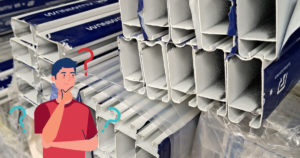Introduction
Ever wondered how the windows in your house or the sleek aluminum frames of your favorite gadgets come to life? Join us on an exciting journey behind the scenes as we unravel the fascinating manufacturing process of glass and aluminum products. From raw materials to the finished wonders, let’s explore the magic that happens before these materials become a part of our daily lives.
1. Raw Materials: The Starting Point of Brilliance
The journey begins with the raw materials. For glass, it’s a mix of sand, soda ash, and limestone. These ingredients are blended together and heated to extremely high temperatures, forming the molten glass we’re familiar with. On the aluminum side, bauxite is mined and refined, undergoing a smelting process to create the strong, lightweight metal we know and love.
Understanding the raw materials for glass and aluminum production:
Understanding the raw materials for glass and aluminum production involves delving into the intricate processes and diverse resources that contribute to the creation of these essential materials. Both glass and aluminum are widely used in various industries, ranging from construction and packaging to automotive and aerospace. Let’s explore the raw materials for each:
Glass Production:
- Silica (Sand):
- Silica, primarily in the form of sand, is a fundamental raw material for glass production.
- The high purity of silica is crucial to ensure the transparency and quality of the glass.
- Soda Ash (Sodium Carbonate):
- Soda ash is added to lower the melting point of silica, making it easier to work with during the manufacturing process.
- It also helps in controlling the solubility of the glass.
- Limestone (Calcium Carbonate):
- Limestone acts as a flux, aiding in the fusion of silica and soda ash.
- It also contributes to the stability and durability of the final glass product.
- Alumina (Aluminum Oxide):
- Alumina is added to improve the hardness and resistance of glass.
- It is especially crucial for the production of certain specialty glasses.
- Cullet (Recycled Glass):
- Cullet is recycled glass that is reintroduced into the manufacturing process.
- Using cullet reduces energy consumption and raw material requirements, making glass production more sustainable.
Aluminum Production:
- Bauxite:
- Bauxite is the primary source of aluminum and is a mixture of minerals such as gibbsite, boehmite, and diaspore.
- The extraction of aluminum from bauxite involves the Bayer process, which refines aluminum oxide from the ore.
- Alumina (Aluminum Oxide):
- Alumina is derived from bauxite through refining processes and serves as the feedstock for aluminum smelting.
- Carbon (Petroleum Coke):
- Carbon is a key component in the reduction of alumina to aluminum during the smelting process.
- Petroleum coke is often used due to its high carbon content.
- Cryolite:
- Cryolite is used as a flux in the aluminum smelting process, lowering the melting point of alumina and improving conductivity.
- Electricity:
- Electricity is a critical input for aluminum production, as the smelting process is energy-intensive, involving the electrolysis of alumina to obtain aluminum.
Understanding the raw materials for glass and aluminum production requires a holistic view of the geological, chemical, and industrial processes involved. Additionally, as sustainability becomes a more significant concern, the recycling of both glass and aluminum is gaining prominence to reduce environmental impact and conserve resources.
2. Glass Melting: Turning Sand into Liquid Gold
The molten glass is a mesmerizing sight. It’s poured onto a bed of molten tin, a process called “float glass,” creating a perfectly smooth and flat surface. This is where the glass gains its clarity and brilliance. It’s then cooled slowly to ensure strength and durability. For special glass types, additional steps like coating or laminating might be involved.
3. Aluminum Extrusion: Shaping the Future
Meanwhile, aluminum is prepared for its transformation through a process called extrusion. Imagine Play-Doh being pushed through a mold to create a specific shape – that’s the basic idea. Aluminum is heated and forced through a die to produce profiles of various shapes and sizes. These profiles are the building blocks for everything from window frames to sleek smartphone bodies.
4. Cutting and Machining: Precision in Every Detail
Once we have our glass sheets and aluminum profiles, it’s time for precision work. Automated cutting machines and CNC (Computer Numerical Control) machining come into play. These machines ensure that every piece is cut to the exact specifications required for the final product. This step is crucial for achieving seamless assembly and a perfect fit.
5. Assembly: Where the Magic Happens
Now comes the exciting part – putting it all together. Glass and aluminum components are carefully assembled, whether it’s creating a window, a sleek door frame, or the housing for a high-tech gadget. This step requires skill and attention to detail to ensure the final product meets the highest standards of quality and aesthetics.
Read more: 10 advantages of using Aluminum in your house project
6. Quality Control: Ensuring Perfection
Before these products make their way to you, they undergo rigorous quality control. Every piece is inspected to ensure it meets the required standards for strength, safety, and appearance. This step ensures that the glass and aluminum products you receive are not only beautiful but also durable and reliable.
Conclusion: From Factory to Your World
And there you have it – the journey from raw materials to the glass windows and aluminum products that enhance our daily lives. The next time you look through a crystal-clear window or hold a sleek gadget in your hands, remember the intricate process that brought these wonders into existence. The world of glass and aluminum manufacturing is truly a blend of science, art, and innovation, shaping the products that make our world shine.




